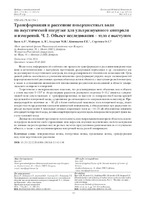Трансформация и рассеяние поверхностных волн на акустической нагрузке для ультразвукового контроля и измерений. Ч. 2. Объект исследования – тело с выступом

Date
2018Publisher
Another Title
Transformation and scattering of surface waves on the acoustic load to ultrasonic evaluation and measurements. Part 2. The object to study – solid with ledge
Bibliographic entry
Трансформация и рассеяние поверхностных волн на акустической нагрузке для ультразвукового контроля и измерений. Ч. 2. Объект исследования – тело с выступом = Transformation and scattering of surface waves on the acoustic load to ultrasonic evaluation and measurements. Part 2. The object to study – solid with ledge / А. Р. Баев [и др.] // Приборы и методы измерений : научно-технический журнал. - 2018. – Т. 9, № 2. – С. 142-154.
Abstract
Недостаток информации об особенностях процессов трансформации и рассеяния поверхностных волн в металлоизделиях с выступами, проточками, радиусными переходами и др. сказывается как на достоверности акустического контроля, так и на расширении его технических возможностей. Цель данной работы заключалась в уточнении механизма трансформации упругих мод и закономерностей формирования полей рассеянных краевых объемных волн в объектах с выступами разной геометрии, а также в установлении возможностей использования результатов исследований в области ультразвукового контроля и измерений. Теоретически и экспериментально показано, что результирующее поле объемных мод в объекте с углом выступа 0–135° и безразмерным радиусом радиусного перехода 0–10,2 является суперпозицией поля сопутствующих и трансформированных на выступе из поверхностной волны краевой продольной и поперечной моды, существенно различающихся по направленности и амплитуде. Превалирующий по величине на ~ 10 дБ и более глобальный максимум поля поперечной моды, лежит в окрестности продолжения плоскости контактной поверхности, а обнаруженные при радиусном переходе выступа менее 1 локальные угловые осцилляции поля до ~10–20 дБ обусловлены влиянием отходящей поперечной моды, возникающей при прохождении вдоль поверхности передней грани выступа головной моды. Данные исследований предложено использовать для ультразвукового контроля объектов сложного профиля на наличие слабо отражающих звук дефектов, изучение акустических свойств материалов по данным скорости краевых мод на разных частотах при удаленном расположении их от изучаемого объекта, а также – для излучения-приема поперечной моды разной поляризации.
Abstract in another language
The lack of information about the features of processes of the surface wave's transformation into volume waves and its scattering in metal objects with ledge, slots, grooves and the others is one of the obstacles to improve of the acoustical testing reliability and widening of technical application. The aim of this work was to study of mechanism of acoustical mode's transformation and determination the laws of the fields forming of scatted volume edge wave's in solids with ledge of different geometry and to suggest direction of the study application in area of acoustical testing and measurements. The features of transformation of surface waves into edge transverse and longitudinal wave modes scatted and their fields forming in the volume of the object with ledge vs. its angle of the slope front surface side (0–135°) and a dimensionless transition radius (0–10,2) varied were studied. Theoretical analysis and experimental data shown that in general case the field of the edge transverse waves in the volume of ledge can be imagined as a superposition of the field of edge waves (scatted on ledge) and accompany waves too, radiated simultaneously with the surface waves to radiate. If dimensionless size of the ledge's transition radius lesser than 1 the resulting field of the edge transverse waves is the summary field of two sources. One of them (with small aperture) is localized in the vicinity of the place of intersection of contact surface with ledge's front side surface. As it was found, the second source of the edge transverse waves – the edge head longitudinal waves to appear in the results of transformation of surface waves on the ledge′s radius transition. The structure of the edge acoustic fields including their extremes vs. ledge's angle and its radius transition, position of the surface wave's probe were experimentally studied and theoretically analyzed. Some directions of the results of researches using are the next: а) ultrasonic testing of hard-to-make technological objects in which defects have low sound reflection; b) ultrasonic structure diagnostics of solid (specimens) set far from the ultrasonic by using edge volume transverse and longitudinal modes; c) creation of new ultrasonic arrangements to sound and to receive transverse waves of different polarization.
View/
Collections
- Т. 9, № 2[8]
